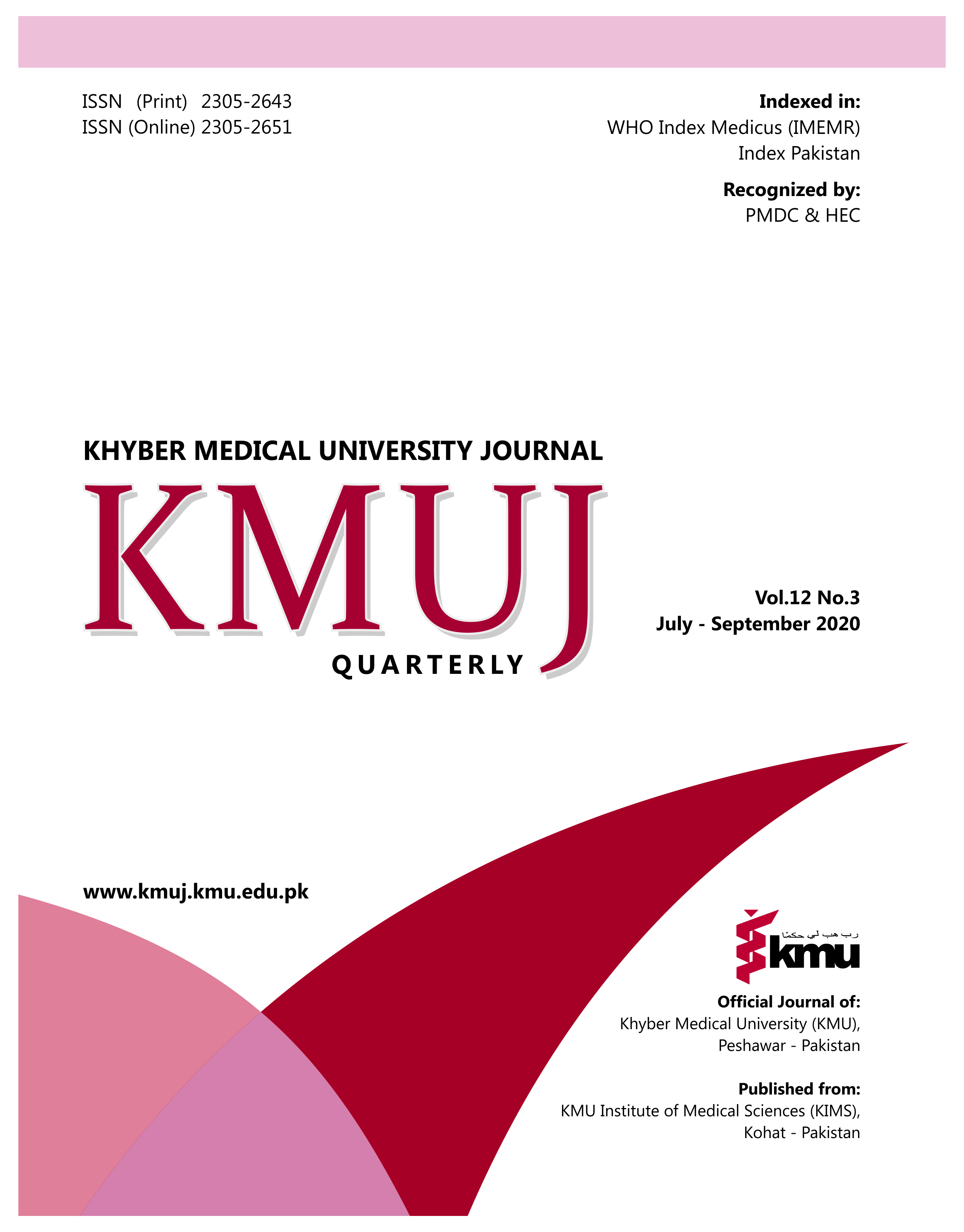CORRELATION OF HANDGRIP STRENGTH WITH ARM ANTHROPOMETRIC VARIABLES IN CRICKETERS
Main Article Content
Abstract
OBJECTIVES: To estimate correlation of handgrip strength with arm anthropometric variables of dominant side.
METHODS: This cross-sectional study was conducted on 241 male cricketers from July 2017 to August 2018 in Lahore using convenient sampling. Arm anthropometric variables and handgrip strength of dominant side were measured by standard anthropometric techniques & formulas. Pearson correlation coefficient & linear regression analysis were applied to find out extent of relationship.
RESULTS: Mean age of 241 players is 25.19±3.493 years. Out of 241 players, 74 (30%) players were batsmen, 69 (29%) were bowlers, 14 (6%) were wicket keepers and 84 (35%) were all-rounder players. Mean handgrip strength of study participants was 65.783±3.365 kg. Mean values for various anthropometric variables included triceps skinfold thickness (13.807±0.815 mm), subscapular skinfold thickness (16.552±0.763 mm), mid arm circumference (33.398±1.274 cm), arm muscle area (67.381±5.149 cm2), arm muscle girth (29.070±1.116 cm), arm area (88.986±6.643 cm2), arm fat area (21.605±1.836 cm2), and arm fat index (24.281±1.055). Handgrip showed positive correlation with triceps skinfold (r=0.608, p=<0.001), mid-arm circumference (r=0.738, p=<0.001), upper arm muscle area (r=0.694, p=<0.001), upper arm muscle girth (r=0.695, p=<0.001), total arm area (r=0.740, p=<0.001), upper arm fat area (r=0.728, p=<0.001), subscapular skinfold (r=0.215, p=0.001), and arm fat index (r=0.158, p=0.013).
CONCLUSION: All the anthropometric variables had a positive significant correlation with handgrip strength. Handgrip strength is standard indicator to achieve target of excellent performance as well as can be made a valuable criterion of selection for cricket & multiple games involving grip.
Article Details
Work published in KMUJ is licensed under a
Creative Commons Attribution 4.0 License
Authors are permitted and encouraged to post their work online (e.g., in institutional repositories or on their website) prior to and during the submission process, as it can lead to productive exchanges, as well as earlier and greater citation of published work.
(e.g., in institutional repositories or on their website) prior to and during the submission process, as it can lead to productive exchanges, as well as earlier and greater citation of published work.
References
Bohannon RW. Hand-grip dynamometry predicts future outcomes in aging adults. J Geriatr Phys Ther 2008;31(1):3-10. DOI: 10.1519/00139143-200831010-00002.
Koley S, Yadav MK, Sandhu JS. Estimation of hand grip strength and its association with some anthropometric traits in cricketers of Amritsar, Punjab, India. Internet J Biol Anthropol 2009;3(1):1-7.
Nicolay CW, Walker AL. Grip strength and endurance: Influences of anthropometric variation, hand dominance, and gender. Int J Ind Ergon 2005 Jul 1;35(7):605-18. DOI: 10.1016/j.ergon.2005.01.007
Taekema DG, Gussekloo J, Maier AB, Westendorp RG, de Craen AJ. Handgrip strength as a predictor of functional, psychological and social health. A prospective population-based study among the oldest old. Age Ageing 2010 May 1;39(3):331-7. DOI: 10.1093/ageing/afq022
Schlüssel MM, dos Anjos LA, de Vasconcellos MT, Kac G. Reference values of handgrip dynamometry of healthy adults: a population-based study. Clin Nutr 2008;27(4):601-7. DOI: 10.1016/j.clnu.2008.04.004
da Silveira TR. Comparison between handgrip strength, subjective global assessment, and prognostic nutritional index in assessing malnutrition and predicting clinical outcome in cirrhotic outpatients. Nutrition 2005;21(2):113-7. DOI: 10.1016/j.nut.2004.02.002
Koley S, Singh AP. Effect of hand dominance in grip strength in collegiate population of Amritsar, Punjab, India. Anthropol 2010;12(1):13-6. DOI: 10.1080/09720073.2010.11891125.
Häger‐Ross C, Rösblad B. Norms for grip strength in children aged 4–16 years. Acta Paediatrica 2002;91(6):617-25. DOI: 10.1080/080352502760068990.
Koley S, Kaur SP. Correlations of handgrip strength with selected hand-arm-anthropometric variables in Indian inter-university female volleyball players. Asian J Sports Med 2011;2(4):220-6. DOI: 10.5812/asjsm.34738
Tahir M. Nazeer MT, Muhammad MZU, Habib B. Anthropometric and Physical Fitness of the Under-16 Regional-School Cricket Players, of Bahawalpur, Pakistan. Glob Region Rev 2018; 3(1): 333-42. DOI: 10.31703/grr.2018(III-I).24.
Ghalea EFA, Peeri M. Comparing some of anthropometric, bio-mechanic and physiologic properties of male elite cricketers of Iran and Pakistan. Int J Biol Pharm Allied Sci 2015;4(5): 2494-501.
Raosoft. Sample Size Calculator: Raosoft, Inc; 2004. [Accessed on: January 24, 2019]. Available from URL: http://www.raosoft.com/samplesize.html.
Surendar J, Indulekha K, Deepa M, Mohan V, Pradeepa R. Association of adiposity, measured by skinfold thickness, with parental history of diabetes in a South Indian population: data from CURES-114. Postgrad Med J 2016;92(1089):379-85. DOI: 10.1136/postgradmedj-2015-133363.
Folasire OF, Akomolafe AA, Sanusi RA. Does nutrition knowledge and practice of athletes translate to enhanced athletic performance? Cross-sectional study amongst Nigerian undergraduate athletes. Glob J Health Sci 2015;7(5):215-25. DOI: 10.5539/gjhs.v7n5p215.
Koley S, Singh J, Sandhu JS. Anthropometric and physiological characteristics on Indian inter-university volleyball players. J Hum Sport Exerc 2010;5(3):389-99. DOI:10.4100/jhse.2010.53.09.
Koley S, Singh J, Kaur S. A study of arm anthropometric profile in Indian inter-university basketball players. Serb J Sports Sci 2011;5(1):35-40.
Koley S, Kaur SP, Sandhu JS. Correlations of handgrip strength and some anthropometric variables in Indian inter-university female handball players. Sport Sci Rev 2011;20(3-4):57-68. DOI: 10.2478/v10237-011-0054-3
Koley S, Singh AP. An association of dominant hand grip strength with some anthropometric variables in Indian collegiate population. Anthropol Anz 2009;67(1):21-8. DOI:10.1127/0003-5548/2009/0003,
